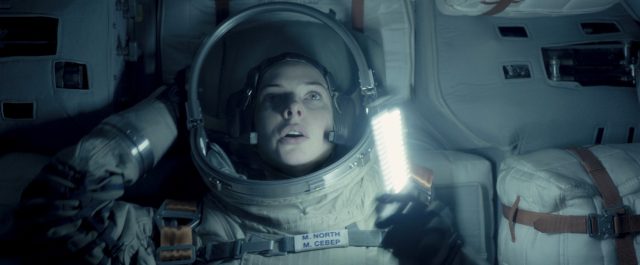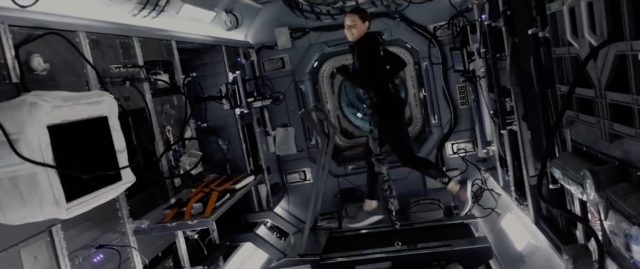We’ve had our eye on LIFE ever since the first trailer dropped back in October. In the film—due in theaters on March 24—a six-person crew of scientists and astronauts aboard a souped-up movie version of the International Space Station intercept a Mars sample return probe; on examination, the probe appears to have brought back at least one viable cell of life from the surface of Mars.
The visuals of a crew working on and in a near-future International Space Station had that same feeling of verisimilitude that made Gravity so compelling to watch—but the movie’s premise seemed to undermine the visuals’ attempts at accuracy. Because, of course, that single cell of life quickly transforms into a space monster and starts killing people.
It’s a tried and true formula, explosively popularized by Ridley Scott’s 1979 masterpiece Alien and echoed with varying degrees of success by multiple films in every decade since. LIFE takes the formula in a bit of a different direction, though, since according to the movie’s second trailer, it’s set not in the far future or even the near future but in the present day.
Space men
We had an opportunity to sit down with a couple of the movie’s science advisors to talk about what the film is and isn’t. First up was retired European Space Agency Project Manager Rudolph “Rudi” Schmidt, who worked on a number of important ESA missions, including Mars Express, Venus Express, and Gaia (space industry protip: “ESA” is pronounced “ee'-suh,” not “E-S-A”).
Schmidt was one of the scientists hired by SKYDANCE as consultants on the film, and his focus was space engineering and the “correctness” of living and working in space. We were excited to talk with him, and questions about scientific accuracy topped our list.

Schmidt explained that he was on set most days, answering the director’s questions about what day-to-day life on the ISS looked like and helping the actors—who were hooked up to wire rigs to simulate microgravity—more correctly move in and around the huge practical set.
While the specifics of the movie’s plot about extraterrestrial life are being held close to the chest, Schmidt confirmed that the film does indeed center on a Mars sample return mission gone wrong. For the sake of drama, the movie upgrades today’s ISS with a fancy extra orbital laboratory module, without which it would be unable to perform any useful science on a sample return. But the logistics of an actual sample return mission aren’t that far out of the realm of possibility.
The trailers show a small sample return vehicle being captured by the future ISS, but Schmidt said getting that sample return vehicle back to Earth in real life would be a challenge. “The biggest challenge still to be solved is the liftoff on Mars because we have never done this,” explained Schmidt. “Landing, I think… there was a learning curve, but we are close now to the situation where the probability for success for landing on the surface is maybe 80 percent, maybe 85. But we have never made a liftoff from the surface.”

Schmidt continued, outlining the difficulty of getting off of Mars. “Number one, there is an atmosphere, which has an aerodynamic impact on the design of the vehicle that lifts off… Secondly, you cannot predict in which conditions the return vehicle will have landed. It can be tilted to the left—it can be tilted to any direction. And the vehicle must be able to compensate during liftoff this misalignment from imperfect orientation because it must reach a very specific orbit to return back to the Earth. If it doesn’t reach a perfect orbit, it’s a disaster.”
Schmidt noted that all of these issues can be overcome, but they are all unknowns today.
It’s alive
Next was space medicine expert Dr. Kevin Fong (who is also featured in the exclusive clip up at the top of the page). Fong is somewhat of a medical renaissance man—a London anesthesiologist who moonlights riding around in helicopters as an emergency doctor and who trained in space medicine for a decade at the Johnson Space Center in Houston. With LIFE, Fong faced a particularly thorny challenge: balancing the contradictory goals of realism and entertainment.
One of the first things I wanted to ask him about was a shot in the trailer of an astronaut working out on a treadmill that vaguely resembled the ISS’ real-life T2 treadmill. Had he asked for that shot to be added for realism’s sake, or had the filmmakers tossed it in on their own?
“No, actually!” he laughed. “They had already sort of dreamt up those exercise sequences… for me it was quite impressive to see how thoroughly they’d researched the basics of that. So that stuff’s already in place, really. We did talk much more closely about what the effects [of microgravity] on the human body were, and from my perspective… it belies the truth, which is that this is an expedition environment, and it’s an expedition environment in the same way that walking to the South Pole, or climbing Everest, or walking into a desert is.”

“And by that,” he continued, “I mean that in spite of all the pretty pictures, this is a place that is the same as all of those extreme environments. When you go there, you can’t go there indefinitely, and when you do go there, there’s a penalty to your physiology and biology.” (In spite of this, Ryan Reynolds still manages to look superhumanly attractive in microgravity.)
Fong echoed something I heard from Schmidt: he, too, was on the movie’s set during filming, and, he, too, had been impressed with how much care was taken to accurately emulate the kinematics of and human reactions to microgravity. There was a movement coach on set who had extensively studied films of astronauts in orbit, but Fong brought to the filmmakers’ attention the most remarkable “zero g” movies ever filmed: Skylab astronauts Al Bean, Pete Conrad, and others running and flipping around in the forward dome of the Skylab space station. Though it had less than half of the International Space Station’s internal volume, Skylab had enormous open internal spaces—far larger than anything on the ISS. This enabled astronauts to do some fantastic tricks and zero-g acrobatics (that’s Al Bean, flipping around like a gymnast). Fong made sure these films were included in the training materials for LIFE.
But human biology isn’t the film’s main focus—this is a movie about alien life. Mars gets all the press, of course, but is it really the number one place in our Solar System where we could look to find extraterrestrial life? What about Europa, or Enceladus, or Titan?
Here, Fong and Schmidt both had essentially the same answer. While the Jovian and Saturnian moons tantalize with hints of potential life, Mars has one overriding advantage: it’s close enough that sending people there would actually be possible with technology not dissimilar from what we have available to us today. It is—budgetary considerations aside—a reasonably close and easy destination. Mounting a crewed expedition to Saturn or Jupiter has been a long-standing staple of science fiction, but at least for now, it remains exactly that.
As to what kind of life there might be on Mars, both Schmidt and Fong feel that Mars’ warm and wet past might have been enough to give birth to life of some unknown amount of complexity. If there’s anything there today, though, odds point to it being extremely simple, extremophilic (at least as we’d define the term when it comes to Earth), and likely subterranean.
That's a far cry from the scary tentacle monster in the trailers—but, hey, it’s just a movie. For now, at least.
LIFE features actors Rebecca Ferguson, Jake Gyllenhaal, and Ryan Reynolds. It was produced by SKYDANCE, distributed by Columbia Pictures, and it's due to hit theaters on March 24. We’re anticipating being able to review the film just before the release.
Listing image by Columbia Pictures
reader comments
44